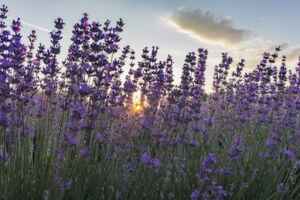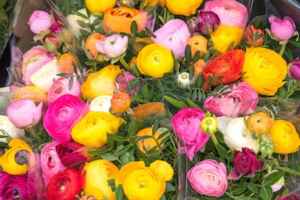Seven Best Flowers for Summer Blooming
There are many beautiful flowers we see all summer. When you see these growing wild they look like a beautiful blanket. It seems like the entire season is filled with these awe-inspiring plants. The truth is very few bloom all summer.
What are some of the flowers that bloom all summer? The top seven flowers that do bloom all summer are sunflowers, daisies, buttercups, zinnias, petunias, lavender, and lastly peonies.
Keep reading to learn more about these beautiful blooming flowers!
Popular Summer Flowers
All of these flowers bloom all summer but not in just the summer months. Some of the flowers will start their blooms in the spring or go from summer to fall.
These seven flowers also grow in differing climates and locations. So whether you are in the humid south or the dry west, there is a flower for you to enjoy all summer long.
 1. Sunflowers
1. Sunflowers
Sunflowers are one of the most iconic summer flowers. With their large blooms and tall stalks, they are hard to miss. They come in many colors such as yellow, brown, white, and red. Sunflowers grow best in full sun and well-drained soil.
There is a lot more to these traditional yellow flowers than meets the eye. The individual flowers that make up the bright yellow petals and fuzzy brown centers are themselves separate blooms. The sunflower bloom may have a maximum of 2,000 flowers.
There are approximately 70 different varieties of sunflowers. The genus name, Helianthus (meaning “sunflower”), is derived from the Greek words for “sun” and “flower”.
Many types of sunflowers are large, bright, and cheerful in appearance. Their forms, on the other hand, can be rather varied. These amusing golden sunflowers resemble puffballs.
2. Daisies
Daisies are another classic summer flower. They come in many colors such as white, yellow, pink, and purple. They have a long blooming season that can last from late spring to late fall. There are over 20,000 different species of daisies.
The genus name, Bellis, is derived from the Latin word for “pretty.” A daisy is a perennial plant with evergreen leaves that form a basal tuft or rosette.
Daisy flower plants have a spreading growth habit or a prostrate style. Daisies may be propagated by division in the spring or through direct sowing of seed in the spring or late fall.
The Northwest United States’ Daisy is a very powerful weed. The daisy flowers blossom at dawn and are frequented by a variety of tiny insects. Daisy leaves are edible, and they can be incorporated into salads.
A daisy is comprised of two sorts of flowers: disk florets and petal-like white ray florets. The disk florets are in the middle and the ray florets are on the outskirts, but they appear to be a single bloom.
3. Buttercups
These flowers are very delicate, but they sure do pack a punch when it comes to color! Buttercups usually come in shades of yellow or white, but some varieties bloom in pink or purple as well.
Tuberous or fibrous roots are characteristic of all buttercups. The flowers are single or grouped in clusters. They have five green sepals, five too many glossy yellow petals, and numerous male and female structures. There are a variety of colored cultivated types.
Depending on the species, the leaves are quite varied. If you are looking for a flower for a more arid area buttercups are not for you. Buttercups are typically found in moist ground. The cup-shaped petals of buttercups often attract bees, which helps with pollination.
4. Zinnias
This beautiful bloom is also very colorful and can be found in a variety of shapes and sizes as well as colors, such as the orange zinnia pictured here. Zinnias are a type of annual and perennial sunflower.
They come in almost every color imaginable, except blue. Zinnia flowers need to be pollinated by bees, butterflies, birds, flies and other animals. It is possible to start zinnias from seed. You can do this either in the spring or summer.
Most zinnias live in the Americas. However, there are a few from Africa. Zinnias have a type of leaf that is long and pointed. Flowers grow in a stem that is either on top or near the side of the plant.
5. Petunias
While petunias can be planted at any time during the year, they flourish in the summertime. They are especially beautiful when planted in hanging baskets.
Petunias are also very easy to propagate. The petals of the petunia come in every color imaginable, including purple, pink, white, yellow, and red. During the winter months, it is necessary to bring your petunias indoors so they don’t freeze.
If you cannot grow them outside over the winter then consider growing them in large pots in your yard. Petunias are most often found in temperate climates, but they can be found in some areas that are hot or cold too! They are mostly annual flowers.
6. Lavender
Some varieties of lavender can grow up to three feet tall and come in shades of blue, pink, or purple. These make a very fragrant addition to any garden!
Lavender flowers are identified by square stems and a woody look. It is also possible to propagate lavenders from cuttings, but this method takes longer than other propagation methods. You can buy plugs of lavender for planting in your garden at many local garden centers or through the internet.
The leaves on the plant are very fragrant, and they are used for scented oils, spices, and tea. The flowers themselves are very intricate. They may be purple or white depending on the variety of plants that you have.
 7. Peonies
7. Peonies
Another classic summer flower is the peony. They come in a variety of colors and grow low to the ground. Just like buttercups, they can also be found blooming in pinks and purples as well!
Peonies typically grow in cold climates and the flowers typically bloom in late spring. They come from China and other parts of Asia, but peonies can be found growing all over the world.
Like most other plants on this list, peonies need to be pollinated by animals like bees or butterflies. It takes a bee about an hour to pollinate just one peony.
Leaves on a peony are typically deep green and are quite large. The petals of the flower are also large and can be quite dramatic. These flowers grow on the top of the stem and can be up to eight inches across.
What Other Months Do They Bloom In?
While these flowers typically bloom in the summer, some of them, like lavender and petunias, can also continue to bloom in other months.
Some of these flowers bloom even start in the spring months and can continue to bloom through autumn. If you are looking for flowers that provide blooms in a variety of months, consider some of these other flowers on this list!
When planting any flower, be sure to check the USDA Plant Hardiness Map before you go shopping so you know which plants will work best in your area.
For example, petunias can bloom into the fall! So, if you’re looking for a flower that will keep on giving all season long, one of these may be perfect for you.
Don’t Roses Bloom All Summer?
Yes, some roses can also bloom all summer long! However, some varieties of roses may only bloom for a few weeks in the summertime.
It is important to do your research to find the best variety of roses for your climate and garden. Roses come in a variety of colors including pink, yellow, white, red, and orange. Some crossbreeds are even striped and multi-colored.
The leaves on a rose bush are typically green, but they can also come in other colors like purple or black. The flowers themselves can be very large and dramatic. They grow on the top of the stem and typically have between five and ten petals.
In Summary
These beautiful flowers come in different varieties ranging from purples to oranges. Annuals or perennials, add a splash of color to your life all summer. By the end of this article, you will know that:
- Zinnias come in almost every color imaginable.
- Petunias are very easy to grow.
- Peonies typically bloom in late spring.
- Lavender can be planted at any time during the year.
- Leaves on a peony are typically deep green and are quite large.
- Petunias can bloom into the fall.
- Sunflowers are typically annual plants.
These flowers come in different varieties ranging from purples to oranges. They may be annuals or perennials, but either way, they are sure to put some color into your life all summer long! If you have questions about what flowers to plant for summer blooms, don’t hesitate to reach out to your local expert!

